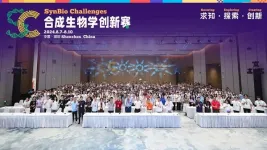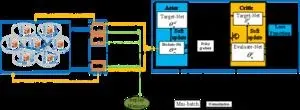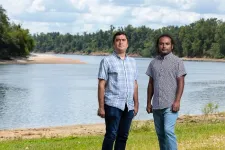Youth igniting the flame of innovation: The third SynBio challenges held successfully in Shenzhen
2024-09-06
(Press-News.org)
From August 7 to 10, the Third SynBio Challenges were held at the Guangming Tianan Cloud Park International Conference Center in Shenzhen, China.
The event was co-organized by Shenzhen Institute of Advanced Technology (SIAT) of the Chinese Academy of Sciences (CAS), Chinese Society of Biotechnology, Shenzhen University of Advanced Technology (SUAT), Shenzhen Institute of Synthetic Biology (iSynBio), Shenzhen Synthetic Biology Association, and the Shenzhen Industrial Innovation Center for Engineering Biology.
The SynBio Challenges aim to provide a platform for students to engage in exchange and competition within the synthetic biology field. This year, the contest attracted 147 teams from over 60 universities, both domestic and international, with more than 450 students participating on-site. Since its inception, the number of participating teams has nearly doubled each year, reflecting the contest’s rapidly growing influence.
At the opening ceremony, ZHANG Xian'en, Chairman of the SynBio Challenges and Dean of the Faculty of Synthetic Biology at SUAT, highlighted that synthetic biology, biotechnology, biomanufacturing, and the bioeconomy are key drivers of innovation today. He expressed hopes for the SynBio Challenges to become the world's second-largest synthetic biology event after iGEM.
The 2024 SynBio Challenges introduced significant upgrades compared to last year. The regular track now includes three new thematic sub-tracks, covering cutting-edge areas in synthetic biology: the green track (Agriculture and Environment), the red track (Biomedicine), and the white track (Biochemical Engineering). These tracks encourage teams to harness their innovation capabilities to address specific social development needs. The Protein Designer and Bacterial Gladiator tracks continued with an Olympic-style competition mechanism, challenging participants’ understanding, strategic problem-solving, and experimental skills.
This year's event also featured a special biological art exhibition and lectures by artists from the Central Academy of Fine Arts, exploring the intersection of science and art and adding a unique dimension to the competition.
After four days of competition among 60 teams, NEFU_China from Northeast Forestry University won the Grand Prize of SynBio Challenges 2024 for their project on de novo 4-hydroxymandelate biosynthesis using metabolic engineering and directed evolution. The team addressed key challenges such as insufficient precursor supply and limited enzyme activity in the biosynthesis pathway.
HELLO-ZJU from Zhejiang University, Shanghaitech-China from ShanghaiTech University, and NEFU_China from Northeast Forestry University won top awards in the Biomedical, Agriculture and Environment, and Biochemical Engineering categories, respectively. In the specialty tracks, the Savage Growth team from Jilin Agricultural University won the Best Bacterial Gladiator Award, while the Nankai Team from Nankai University and Helix Heroes from Shanghai Jiao Tong University won the Best Protein Design Award.
In an interview, Jian Mei from Waseda University in Japan expressed his admiration for Shenzhen’s advanced synthetic biology infrastructure, noting its high level of automation and cutting-edge technology. As a member of the first foreign team to participate in the SynBio Challenges, he hopes to expand the contest’s influence to more international teams.
At the closing ceremony, LIU Chenli, Vice President of SIAT and Founding Director of the National Industrial Innovation Center for Biomanufacturing (NIICB) and Shenzhen Institute of Synthetic Biology (iSynBio), highlighted the importance of SynBio Challenges in fostering innovation and creativity. He encouraged participants to delve into the scientific principles of synthetic biology and explore innovative applications across various fields.
This year's SynBio Challenges embodied the core concept of synthetic biology, "build to learn, build to use," highlighting the driving force of interdisciplinary integration and innovation. Participating teams showcased diverse research directions and distinctive innovative ideas.
END
[Attachments] See images for this press release:


ELSE PRESS RELEASES FROM THIS DATE:
2024-09-06
Cruciferous vegetables, including broccoli, cabbage, kale, and cauliflower have been found to lower blood pressure, in comparison to root and squash vegetables, in middle-aged and older Australian adults with elevated blood pressure.
In a randomised, controlled, crossover trial, researchers from Edith Cowan University (ECU) found that consuming four serves a day of cruciferous vegetables resulted in a significant reduction in blood pressure, compared with four serves a day of root and squash vegetables including carrot, potato, sweet ...
2024-09-06
Dynamic service migration is a key technology in Mobile Edge Computing(MEC). In a multi-user service migration scenario, the states of all users are combined into a global state, which leads to the instability of the system and ignores the influence of multiple users. It is more and more challenging to design an effective migration strategy to balance migration costs and latency in a multi-user distributed environment.
To solve the problems, a research team led by Degan ZHANG published their new research on 15 August 2024 in Frontiers of Computer Science co-published by Higher Education Press and Springer Nature.
Considering ...
2024-09-06
Scientists at Huntsman Cancer Institute at the University of Utah (the U), the National Cancer Institute-designated cancer center for the Mountain West, have made a significant breakthrough in predicting the prognosis of triple-negative breast cancer (TNBC), a particularly aggressive disease. Their research, published in JCO Precision Oncology as part of the TOWARDS study, has led to the development of a new mechanism that accurately forecasts the aggressiveness of TNBC. This advancement could revolutionize the way doctors treat TNBC, allowing them to identify higher-risk patients and tailor precise treatments.
Currently, TNBC lacks reliable methods to predict recurrence after ...
2024-09-06
SEQUIM, Wash.—Officials gathered at the Sequim campus of the Department of Energy’s Pacific Northwest National Laboratory today to dedicate DOE’s first hybrid-electric research vessel, RV Resilience.
The event marks the start of a new era of marine energy research at PNNL-Sequim, part of DOE’s Office of Science national laboratory system and Resilience’s new home port. Speakers at the dedication included U.S. Sen. Maria Cantwell, U.S. Rep. Derek Kilmer, Washington State Rep. Steve Tharinger and representatives from DOE and PNNL.
“DOE is focused on ...
2024-09-06
ROCHESTER, Minn. — About 8 to 10 million Americans over age 40 have an overabundance of cloned white blood cells, or lymphocytes, that hamper their immune systems. Although many who have this condition — called monoclonal B-cell lymphocytosis (MBL) — do not experience any symptoms, a new study shows they may have an elevated risk for several health complications, including melanoma, a form of skin cancer. The findings, by Mayo Clinic researchers, are published in a new paper in the Journal ...
2024-09-06
PHILADELPHIA— The vision of people with a rare inherited condition that causes them to lose much of their sight early in childhood was 100 times better after they received gene therapy to address the genetic mutation causing it. Some patients even experienced a 10,000-fold improvement in their vision after receiving the highest dose of the therapy, according to researchers from the Perelman School of Medicine at the University of Pennsylvania who co-led the clinical trial published in The Lancet.
“That 10,000-fold improvement ...
2024-09-06
After the treatment, one patient saw her first star. Another saw snowflakes for the first time. Other patients were newly able to navigate outside of the home or to read the labels on their child’s Halloween candy.
The cause of these seemingly miraculous improvements? A gene therapy developed by University of Florida scientists, which restored useful vision to most patients with the rare, inherited blindness known as Leber congenital amaurosis type I, or LCA1, in a small trial.
Those who received the highest dose of the gene therapy saw up to a 10,000-fold improvement ...
2024-09-06
Near the Florida-Georgia border, the Chattahoochee and Flint rivers meet and become the Apalachicola River, which carries freshwater and nutrients downstream to the Apalachicola Bay.
New research led by FAMU-FSU College of Engineering Assistant Professor Ebrahim Ahmadisharaf examined how drought and water volume in the Lower Apalachicola River watershed affect nitrogen and phosphorous, crucial nutrients for a healthy aquatic ecosystem. The study was published in Water Research.
“In watershed systems like this, that are subject to regulations upstream, knowing how the ecosystem reacts to changes helps us manage it effectively,” said Ahmadisharaf, ...
2024-09-06
Rice and spinach are staples for babies’ and young children’s diets, but toxic metals and metalloids found in those foods can cause severe health impacts.
In particular, heavy metals such as cadmium, lead, mercury, and metalloid arsenic could delay brain development in babies and young children.
In new research published in the academic journal Environmental Geochemistry and Health, University of Delaware scientists have found that flooded rice fields tend to contain higher amounts of arsenic and lower amounts of cadmium. The drier those rice fields are, the lower the amounts of arsenic and the higher the amounts of cadmium. However, the higher cadmium is lower ...
2024-09-06
Using hypertonic saline nasal drops can reduce the length of the common cold in children by two days, according to a study that will be presented at the European Respiratory Society (ERS) Congress in Vienna, Austria [1]. They can also reduce the onward transmission of colds to family members.
The results of the ELVIS-Kids randomised controlled trial were presented by Professor Steve Cunningham from Child Life and Health, University of Edinburgh, UK.
He said: “Children have up to 10 to 12 upper respiratory tract infections, what we refer to as colds, per year, which ...
LAST 30 PRESS RELEASES:
[Press-News.org] Youth igniting the flame of innovation: The third SynBio challenges held successfully in Shenzhen





